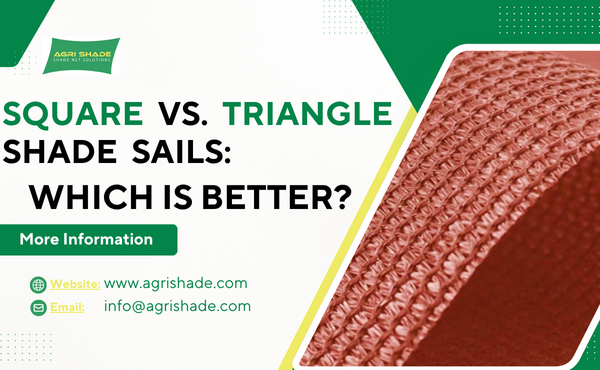Greenhouses provide a controlled environment for plants, but even within these structures, managing light and temperature is critical. One of the most effective ways to control these factors is by using shade cloth. Shade cloths can protect plants from excessive heat, prevent sunburn, and improve overall growth.
However, choosing the right shade cloth percentage is essential for achieving optimal results. This guide will help you understand shade cloth percentages and how to select the right one for your greenhouse plants.
Percentage of Shade Cloth Explained
Light Transmission
Shade cloth works by blocking a specific amount of sunlight from entering the greenhouse. The percentage on the label shows how much light the material blocks. For example, a 50% shade cloth blocks half the sunlight, letting the other half reach the plants.
Tip: Growers can use a lower percentage for sun-loving crops and a higher percentage for delicate or shade-loving varieties.
A higher shade cloth percentage means less light passes through. This helps prevent overheating and sunburn in sensitive plants. Gardeners in hot climates often choose a higher percentage to protect their crops.
Plant Health Impact
The right shade cloth creates a balanced environment for plant growth. Too much sunlight can stress plants, causing wilting or leaf burn. Too little light can slow growth and reduce yields.
- Heat-loving vegetables like tomatoes thrive under 30% shade cloth.
- Most flowers and leafy greens prefer 40-50% shade cloth.
- Ferns and orchids need 75-90% shade cloth for best results.
Choosing the correct shade cloth percentage supports healthy photosynthesis. Healthy plants grow faster, resist disease, and produce better harvests. Every grower should match their shade cloth to their plant’s needs for the best results.
Common Shade Cloth Percentage Options
30% Shade Cloth
Gardeners often choose 30% shade cloth for heat-loving plants. This option allows most sunlight to reach crops like tomatoes, peppers, and squash. Growers in cooler or northern regions benefit from this level because it protects plants without blocking too much light.
Note: 30% shade cloth works best for greenhouses that need to maximize sunlight while still reducing the risk of leaf burn.
40-50% Shade Cloth
Many growers select 40-50% shade cloth for general greenhouse use. This range suits a wide variety of vegetables, herbs, and flowers. It provides a balance between sun protection and healthy light levels.
- Use 40% shade cloth for leafy greens and lettuce.
- Choose 50% shade cloth for mixed crops or when growing in southern climates.
- This option helps prevent overheating and supports steady plant growth.
75-90% Shade Cloth
Shade-loving plants thrive under 75-90% shade cloth. Ferns, orchids, and some tropical flowers need this high level of protection. Greenhouses in hot, sunny areas also use this option to shield delicate plants from intense sunlight.
A higher percentage of shade cloth creates a cooler environment. Sensitive seedlings and young plants benefit from this extra protection. Growers who want to reduce heat stress should consider this option.
Choosing the Right Shade Cloth
By Plant Type
Selecting the right shade cloth starts with knowing the needs of each plant. Vegetables like tomatoes and peppers need more sunlight, so a lower percentage works best. Flowers and leafy greens often thrive with moderate coverage, while ferns and orchids demand the highest protection.
Tip: Group plants with similar light needs together in the greenhouse for easier management.
A grower who raises both vegetables and shade-loving plants should consider separate zones or adjustable shade cloth. This approach ensures every plant receives the right amount of light. Healthy plants reward growers with better yields and vibrant growth.
By Climate
Climate plays a major role in choosing the right shade cloth. In hot, sunny regions, a higher percentage prevents overheating and sunburn. Growers in cooler climates or northern areas benefit from lower percentages that allow more sunlight into the greenhouse.
A simple rule helps: North of the 40th parallel, use less shade; south of this line, increase coverage. This guideline matches sunlight intensity to plant needs. Adjusting the shade cloth for seasonal changes also boosts plant health.
Note: Monitoring temperature and light levels inside the greenhouse helps growers fine-tune their shade cloth choice.
By Greenhouse Location
The greenhouse location affects how much sunlight reaches the plants. A structure facing south or west receives more direct sun and may need a higher percentage of shade cloth. Greenhouses shaded by trees or buildings can use a lower percentage.
Mixed-use greenhouses, which house a variety of plants, benefit from flexible solutions. Removable panels or layered shade cloth allow growers to adapt to changing needs. This flexibility ensures every plant gets the right protection.
A well-placed greenhouse with the right shade cloth creates the perfect environment for growth. Growers who adjust their shade cloth based on location see stronger, healthier plants.
Recommended Shade Cloth Percentages
Vegetables
Vegetables need the right density to grow strong and healthy. Tomatoes, peppers, and squash thrive with a shade cloth density of 30%. This level allows enough sunlight for photosynthesis and prevents leaf burn.
Growers who want higher yields should match the density to the crop’s sunlight needs.
Fruits
Fruit crops require careful attention to density. Strawberries and melons perform best under a shade cloth density of 40-50%. This range protects fruit from sun damage and supports steady ripening.
- Use 40% density for berries in cooler climates.
- Choose 50% density for melons in warmer regions.
Flowers and Ornamental Plants
Flowers and ornamentals respond well to moderate or high density. Most flowering plants prefer a shade cloth density of 50%. Ferns and orchids need a higher density, between 75% and 90%, to avoid stress from intense sunlight.
| Plant Type | Recommended Density |
|---|---|
| Roses | 50% |
| Ferns | 75-90% |
| Orchids | 75-90% |
Seedlings and Young Plants
Seedlings and young plants benefit from extra protection. A shade cloth density of 75-90% shields them from harsh rays and reduces heat stress. This high density creates a gentle environment for root development.
Tip: Adjust the density as seedlings mature to encourage strong growth.
Growers who select the right density for each plant group see healthier crops and better results.
Conclusion
Choosing the right shade cloth percentage is essential for creating a balanced greenhouse environment. By considering plant type, local climate, and greenhouse location, growers can protect crops from excessive heat and sunburn while ensuring enough light for healthy growth.
Matching shade cloth density to the specific needs of vegetables, fruits, flowers, and seedlings promotes stronger plants, higher yields, and more vibrant crops. With careful selection and proper adjustment, shade cloth becomes a simple yet powerful tool to optimize greenhouse conditions year-round.


















